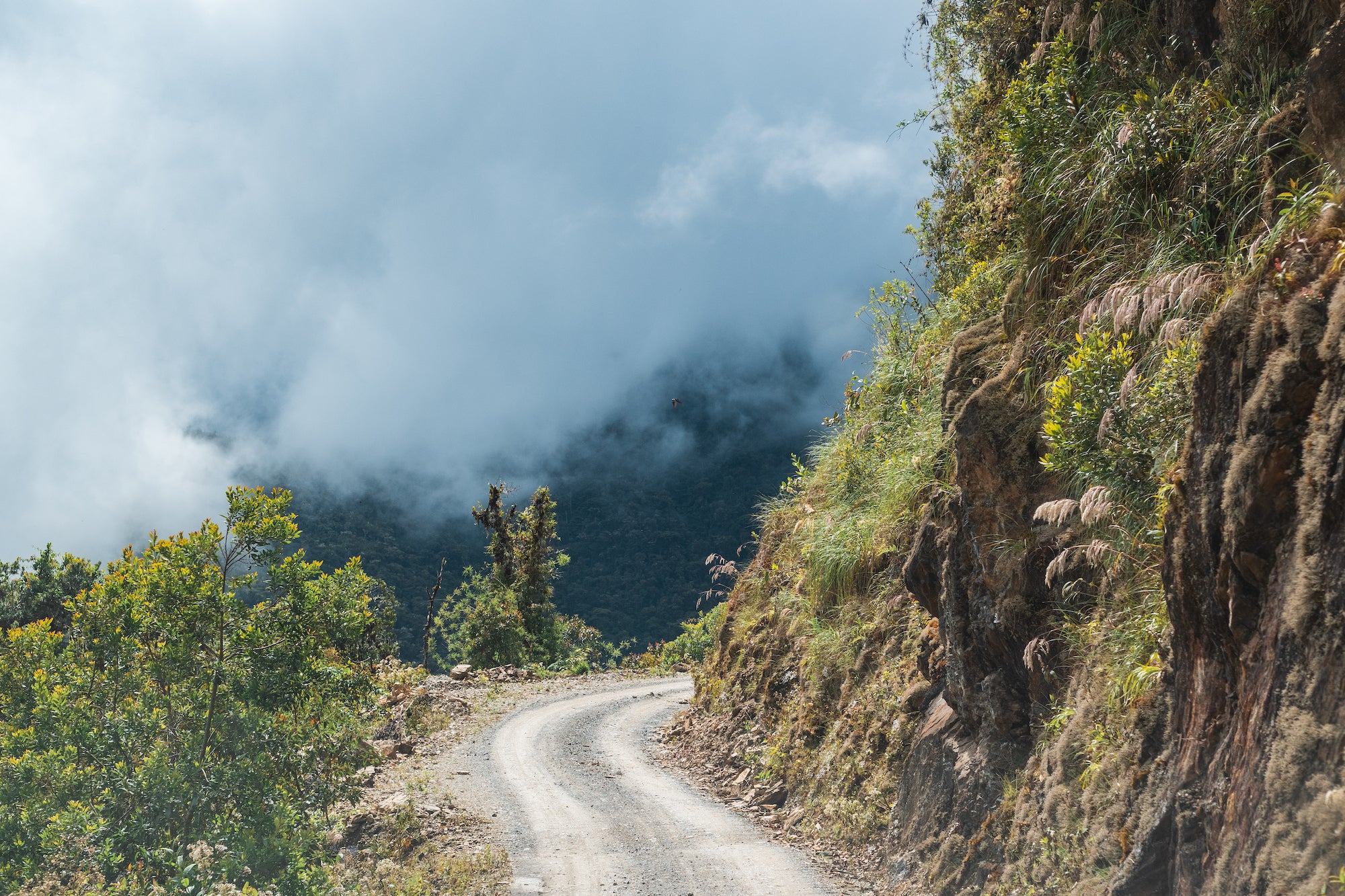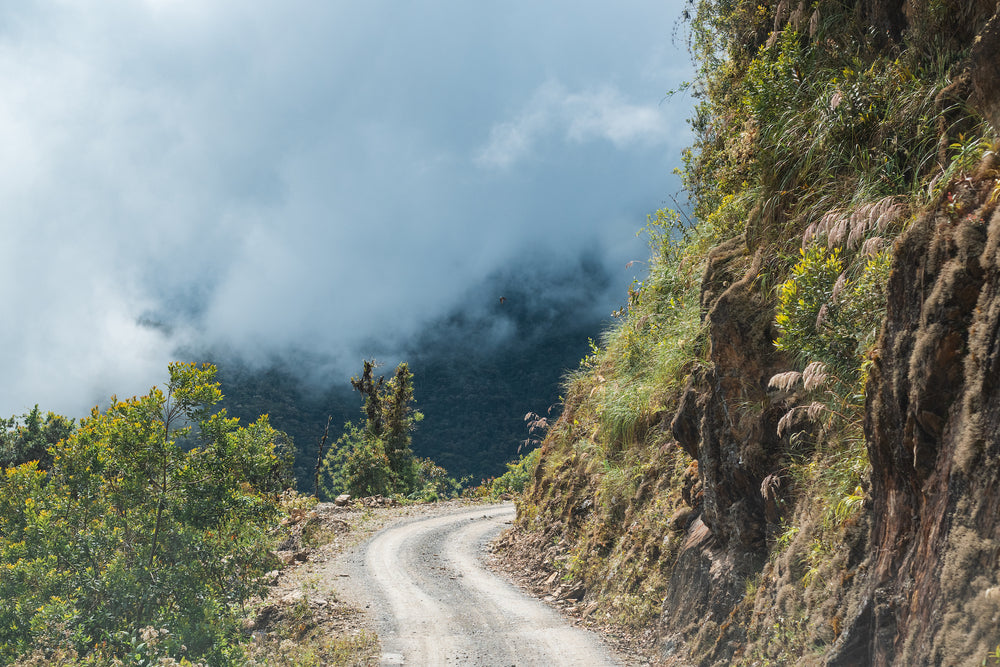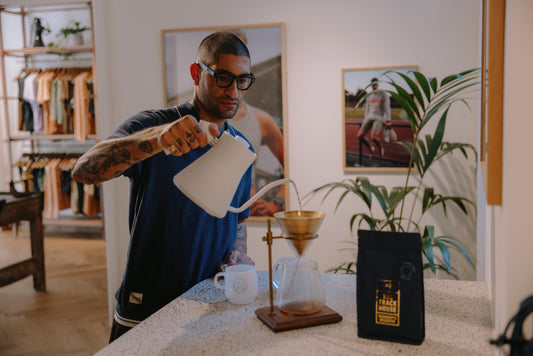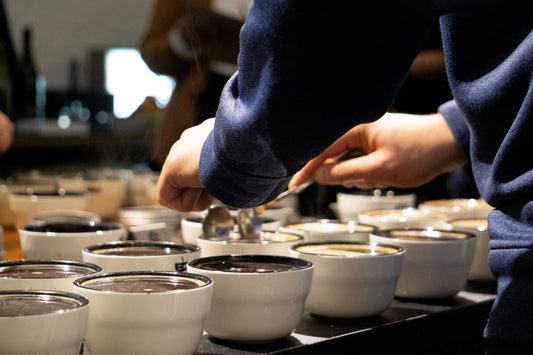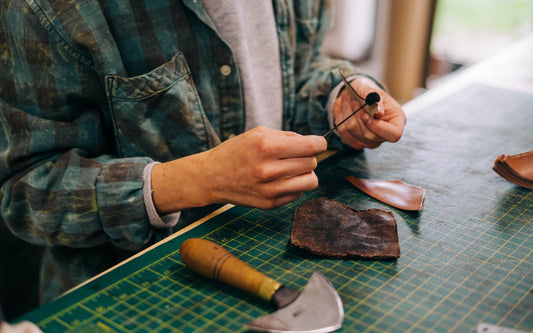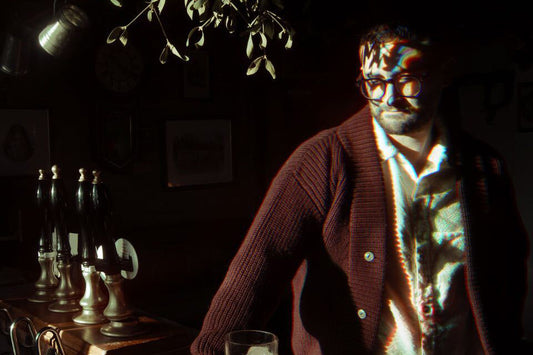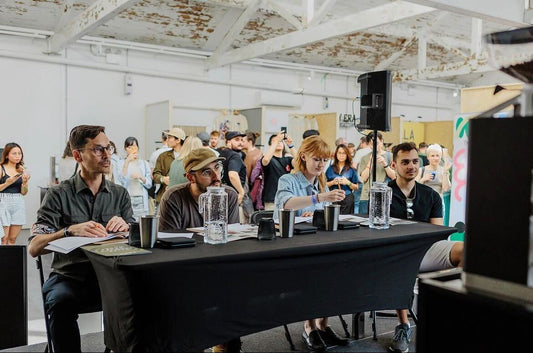 Driving to Perú Profundo.
Driving to Perú Profundo.
As we approach our 9th birthday, it's impressive to think how far we've come in that time. Starting with a roll-call of just seven producing countries - Kenya, Ethiopia, Rwanda, Costa Rica, El Salvador, Brazil and Colombia. Today, we buy from double that number. Fourteen different origins now keep us, and you, supplied with delicious, fresh coffee all year-round. This increase has been brought about through ourselves expanding our horizons, coupled with quality programs in countries that have resulted in delicious coffees becoming abundant in more places.
However, we can't rely on finding the best coffees from new origins whilst sitting in Bethnal Green. Trips oversea are required, this time to the thirteenth country we've had the pleasure of visiting. That country? Peru.
 Unreal scenery on the road to Calca town.
Unreal scenery on the road to Calca town.
 Hairpin turns on the roads, pretty much all the way.
Hairpin turns on the roads, pretty much all the way.
 One of the benefits of setting off before sunrise is getting to see the early light dancing through the clouds.
One of the benefits of setting off before sunrise is getting to see the early light dancing through the clouds.
The first three coffees, purchased for our hotel coffee programme last year, all came from the historic region of Cusco in southern Peru. With this the focus of our trip, we arranged to meet the association of farmers behind two of the lots; Valle Inca Group.
The newly elected president of Valle Inca, 29-year-old José Prudencio, greeted us on our arrival in Cusco before driving us to the nearby town of Calca. Home to the cupping lab, warehouse and offices of Valle Inca, they provide agronomical advice, along with financing for farmers to implement infrastructure improvements in their land.
 Cool storage for the coffee at Valle Inca’s warehouse in Calca, 2,980m.
Cool storage for the coffee at Valle Inca’s warehouse in Calca, 2,980m.
 Beautiful clean parchment coffee from one of the association’s members.
Beautiful clean parchment coffee from one of the association’s members.
Growing up, José used to pick coffee with his father, sleeping on sacks of coffee after a long, hard day's work. Enthusiastic and incredibly hard-working, he tries to connect as frequently as possible with the members even though they live in incredibly remote areas around Cusco. José's goal is to connect all the small scale producers in the group with buyers by finding the correct market for their coffees. Having paid $5,000 last year for an organic certificate, applicable to all their producers, gives Valle Inca an edge in marketing their coffee to specific buyers, especially those in the US. Word has spread about the group and the positive work they're doing, that has seen numbers grow from 100 members last year to 200 at the current count. However, being a member of Valle Inca isn't just about having the right coffee varieties like Typica or Bourbon. A willingness to improve, adapt and possess the right mindset is crucial if a farmer is to benefit from everything membership to Valle Inca has to offer.
Along the narrowest of Andean roads, as we climbed well above the clouds to 4,568m at our peak, a myriad of frozen lakes, thermal springs, Incan ruins and waterfalls flashed by on the long journey to visit the remote farms of members. We were most definitely in 'Perú Profundo' (Deepest Peru) and, unapologetically, a little unsettled at times as we witnessed José both cross himself and mutter a quick prayer as he navigated the seemingly endless blind, hairpin corners. Llamas, alpacas, vicuña, sheep and wild horses were plentiful to spot, but sightings of the secretive puma or bears wearing red hats remained, unfortunately, elusive.
 Beautiful animals roam the historic countryside.
Beautiful animals roam the historic countryside.
 We shared the roads with plenty of animal herders.
We shared the roads with plenty of animal herders.
It's a strange feeling, descending to coffee farms, as we usually climb when in most producing countries. After several hours in the car, with any remnants of phone reception lost much earlier in the day, we arrived at Finca Progreso in Huaynapata, the farm of Agustin Ccasa Ccoyo. Due to the remoteness of the farm, when José wishes to visit or collect coffee, he must first visit Quebrada. There, at the local radio station, he transmits a message to Agustin as they have no other means of communication; hopefully he's within earshot! Luckily our trip was pre-planned, so Agustin knew to expect us, greeting us on arrival.
Having bought 20 sacks of his coffee last year, it was a pleasure to meet Agustin and witness his farm and production techniques first-hand. With mineral-rich black volcanic soil and situated at 2,150m, his farm has incredible agricultural conditions for coffee!

The mature cherries here are very large, growing at 2,150m.
 The view from Augustin's house, where he relishes the peace and quiet gained from being so remote.
The view from Augustin's house, where he relishes the peace and quiet gained from being so remote.
 The mature cherries here are very large, growing at 2,150m.
The mature cherries here are very large, growing at 2,150m.
Predominantly growing Red Bourbon, Agustin explained that coffee produced above 1,650m in Peru sees both Roya and Broca become much less prevalent. Rise above 1,850m, however, and these two major threats are, thankfully, all but non-existent. However, humidity is an issue in Huaynapata, so Agustin lets his trees grow tall, pruning back any growth on the first metre of the trunk to allow better ventilation between the trees, reducing the chance of moulds. The resulting willowy three-metre trees are too tall to harvest normally, so workers, armed with a rope and hook, bend the trees as they pick.
 Clearing the first metre or so of growth to create better ventilation.
Clearing the first metre or so of growth to create better ventilation.
 Agustin amongst his bourbons.
Agustin amongst his bourbons.
 Thankfully for Agustin and his pickers the tall coffee trees are willowy and supple, able to bend over to pick.
Thankfully for Agustin and his pickers the tall coffee trees are willowy and supple, able to bend over to pick.
In processing their coffee cherries, they first float in water to skim off the less dense fruit. Fed through a manual disc depulper to remove the seed from the fruit, the depulped parchment is then sieved to remove any coffee cherry skins.
 Floating any damaged or unripe coffee cherries.
Floating any damaged or unripe coffee cherries.
 Happy depulping!
Happy depulping!
Experimenting in their approach to fermentation, they place the mucilage laden parchment coffee into GrainPro sacks and then seal in a plastic barrel. A tube allows for degassing, as the microbiome breaking down the coffee's mucilage produces CO2 during this stage. After 24-28 hours, the fermented coffee is washed before being put out to dry on their tiered, raised beds in a ventilated secadore (solar dryer).
 Ready to ferment in barrels.
Ready to ferment in barrels.
 Turning the parchment coffee whilst drying.
Turning the parchment coffee whilst drying.
Back at the farmhouse, we chatted over a strong coffee. Brewed in the 'Gota Gota' (Drip Drip) method and roasted in a traditional Q'analla (a clay pot pronounced with a click on the Q), it was the perfect accompaniment to the chirimoyas we munched on. Having farmed coffee here for decades, we discovered we were the first buyer to visit! A freshly slaughtered rooster soon became a hearty broth made in our honour and, coupled with some beers, we raised a toast to Pachamama (the Quechuan name for Mother Earth) to thank her for providing everything she does.
 A toast to Pachamama when the work is done.
A toast to Pachamama when the work is done.
 José Prudencio preparing Gota Gota coffee.
José Prudencio preparing Gota Gota coffee.
 Agustin's wife and her Q’analla. #shestheroaster
Agustin's wife and her Q’analla. #shestheroaster
 Preparing vegetables for lunch.
Preparing vegetables for lunch.
The next day we set out to visit Ricardo Ccallo at Finca Pampa Blanca in Quinuay, from whom we bought 50 bags of coffee last year.

 This feels like Mars.
This feels like Mars.

 Beautiful still lakes added to the eerie quality of this region.
Beautiful still lakes added to the eerie quality of this region.
 No shortage of breathtaking views.
No shortage of breathtaking views.
With a very different environment to that on Agustin's farm, Pampa Blanca is much drier and windier. Growing mostly Typica on his 1,900m farm, Ricardo actively tries to keep moisture in the soil by leaving any fallen matter from shade trees along with any spent Coca leaves, chewed by workers as they pick, which grows in rows amongst the coffee.
 Ricardo amongst his typica trees.
Ricardo amongst his typica trees.
 The quantity and health of the flower buds will determine the fruitset.
The quantity and health of the flower buds will determine the fruitset.
He also creates a rich compost, mostly from chicken and guinea pig droppings, as well as spent coffee pulp, which worms break down into rich black humus. A good handful is added to each tree just before the rains come, to help distribute the nourishing organic fertiliser, with any trees looking less vigorous receiving two handfuls of the nutrient-rich mulch.
 Home to Ricardo’s homemade compost.
Home to Ricardo’s homemade compost.

Black and rich in nutrients for his coffee trees.
Farming coffee here for 25 years, most of Ricardo's trees are between 20 and 30 years old. All trees get pruned right back every 6-8 years, but he admitted that some of his farm requires replanting soon.

 Newly planted typica trees and shade trees for when they’re older.
Newly planted typica trees and shade trees for when they’re older.
Ricardo likes to very gently and smoothly manually de-pulp the coffee, which he says is only achievable with a ripe harvest. With the sugars acting as a lubricant, it makes the job of turning the hand crank that little bit easier.

 Ready to process a tiny batch.
Ready to process a tiny batch.
 Floatation is still performed with these small pickings.
Floatation is still performed with these small pickings.
Once sieved to remove cherry skin, large batches ferment in a plastic-lined tank with a lid placed on top. Smaller lots, which have been more prevalent this year, are processed in the same manner as Agustin; bags sealed in barrels to perform what they call an "anaerobic fermentation".
Ricardo wakes around 3 am to wash his coffee when fermentation is complete as he wants to get it out into the rising sun to maximise the hours of sunlight available. Dried on black mesh on patios and under a plastic roof with both sides open for ventilation, Ricardo wishes to eventually invest in raised beds to have more control over his drying.
 The biggest and best avocado I've ever eaten.
The biggest and best avocado I've ever eaten.
As we sat down for a very late, but delicious lunch of yucca, rice, broth, Ricardo handed me the largest avocado I've ever seen!
 Heading home.
Heading home. Well above the clouds.
Well above the clouds.
Back at the Valle Inca lab in Calca, we cupped some fantastic coffees from other members in the Valle Inca association with José explaining some of the very in-depth processing techniques being employed to maximise the potential for quality on each of the farms.
As we had a flight to catch in Cusco, some hurriedly prepared samples passed through the huller before being visually graded. In removing visible defects and screen sizing the coffee to take only 15+ size beans, José mimicked the process at the dry mill allowing us to cup again back in London.

 A sample of clean parchment coffee.
A sample of clean parchment coffee.
Back in Lima, we visited the Expo Café dry mill, where the parchment coffee will arrive after a 32-hour drive from the cool warehouse at 2,980m in Calca. Here we witnessed how the coffee is graded and refined, from initially checking certain physical traits like the moisture content of the coffee, through to hulling, size grading, density grading and optical sorting.

 One of many cuppings during our travels in Peru.
One of many cuppings during our travels in Peru.
Peru is a fantastic country, and in travelling to visit Agustin and Ricardo, we witnessed some of the most breathtaking yet remote scenery imaginable. We promise to follow up soon with the announcement of those lots we've chosen and are sure you'll be mightily impressed with the quality in the cup. Workshop will be back.
Share:


